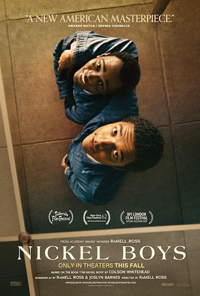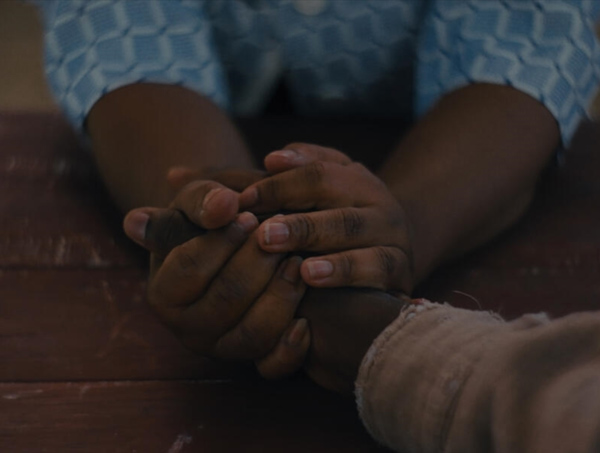No Country for Black Men: Ross Reforms the Cinema with Distinctive Adaptation
 In many ways, Nickel Boys, the narrative debut from director RaMell Ross, feels like an exemplification of ‘it was the best of times, it was the worst of time’ in its depiction of trauma and abuse inflicted upon two teenage Black boys at an infamous Floridian reform school in the 1960s. While what’s ‘worst’ needs no further explanation, the ‘best’ arrives in Ross’ inventive adaption of Colson Whitehead’s Pulitzer Prize winning 2020 novel, shot in a first-person point of view. Although Ross isn’t the first to utilize this perspective, it’s a device historically applied to genre titles, perhaps most notably in Robert Montgomery’s 1947 adaptation of Raymond Chandler’s The Lady in the Lake. More recent attempts include the explicit music video for The Prodigy’s 1997 single “Smack My Bitch Up,” or Steven Soderbergh’s upcoming supernatural thriller Presence (2024). Ross’ narrative arrangement, chopped into nonlinear aesthetics recalling his Academy Award nominated documentary Hale County, This Morning, This Evening (2018), pares this into a simplistic but compelling orientation which builds to a devastating crescendo during the film’s final moments.
In many ways, Nickel Boys, the narrative debut from director RaMell Ross, feels like an exemplification of ‘it was the best of times, it was the worst of time’ in its depiction of trauma and abuse inflicted upon two teenage Black boys at an infamous Floridian reform school in the 1960s. While what’s ‘worst’ needs no further explanation, the ‘best’ arrives in Ross’ inventive adaption of Colson Whitehead’s Pulitzer Prize winning 2020 novel, shot in a first-person point of view. Although Ross isn’t the first to utilize this perspective, it’s a device historically applied to genre titles, perhaps most notably in Robert Montgomery’s 1947 adaptation of Raymond Chandler’s The Lady in the Lake. More recent attempts include the explicit music video for The Prodigy’s 1997 single “Smack My Bitch Up,” or Steven Soderbergh’s upcoming supernatural thriller Presence (2024). Ross’ narrative arrangement, chopped into nonlinear aesthetics recalling his Academy Award nominated documentary Hale County, This Morning, This Evening (2018), pares this into a simplistic but compelling orientation which builds to a devastating crescendo during the film’s final moments.
In 1962 Tallahassee Florida, Elwood’s (Ethan Herisse) bright future is blighted by being in the wrong place at the wrong time, and he’s sentenced to an indefinite stay at a segregated reform school for boys called the Nickel Academy. Once there, a chilly ‘instructor’ (Hamish Linklater) informs the incoming student body of a vague process which allows their behavior to dictate how long they will stay. However, it would seem this is nearly impossible to achieve for some of the boys. He finds a friend in Turner (Brandon Wilson), and together they witness and experience rampant abuse and trauma as they’re forced into various forms of manual labor from which the school economically benefits. When Elwood begins to document the wrongdoings he witnesses and plans to reveal his information to some inspectors, his life is suddenly in danger. Together, the two friends plan to escape.
How Nickel Boys visualizes trauma also captures the inherent compartmentalization of it. In essence, the entire film is a defense mechanism against everything happening just outside the frame of its characters’ visual comprehension (and thus, our own). This becomes even more inherent with the time jumps to the late 1980s and early 2000s, where an adult Elwood is portrayed by Daveed Diggs but only shot from behind, who has lost this first-person perspective as an adult. Essentially, he’s stuck in the past he’s survived, in ways which are eventually revealed as more devastating than we’d imagine. This depiction of the past’s stronghold recalls a moment in Taylor Hackford’s adaptation of Stephen King’s Dolores Claiborne (1995), wherein forgotten sexual abuse inflicted upon Jennifer Jason Leigh’s character flood back to the present, and she’s only able to see the back of her head in a mirror’s reflection.
Beyond the innovative visual approach, the strength of Nickel Boys exists in its depiction of a friendship which blooms partially as a survival tactic, as the relationship between the studious, outspoken Elwood and the reluctant Turner is somewhat hard-won. Ross switches between their perspectives, most notably of their first interaction in the cafeteria. What this establishes is the curious effect of not being able to witness a character’s visual reactions, denying a sense of audience agency, like a futile specter forced to process our own emotional response to the trauma without the guide of any resiliency cues. Tossed into this is Elwood’s grandmother Hattie, played with empathetic prowess by the great Aunjanue Ellis-Taylor. There are two sequences involving a hug between Hattie and Turner which sail past the realm of comfort into incredible anguish.

Whitehead’s novel is a fictionalization of the Dozier School for Boys, which was in operation from 1900 to 2011. A year later, burial sites began to be identified. While many of the boys incarcerated at the school were white, it is estimated at least three times as many Black students were murdered. Both the novel and the film represent a recuperative attempt at determining what it was like for them, and how Black bodies are deemed as either invisible or interchangeable. Ross repeatedly references scenes from Stanley Kramer’s classic The Defiant Ones (1958), wherein prisoner Sidney Poitier is changed to the racist Tony Curtis as they flee authorities, eventually bonding over the experience. While Nickel Boys is hardly as black and white as Kramer’s social justice exercises were, there is a subversive hierarchy afoot, the lighter skinned Turner more easily intimidated by a system partially because he arguably benefits from the colorism which posits him closer to the power structure than Elwood.
Lensed masterfully by Jomo Fray (following up on his equally sterling work in All Dirt Roads Taste of Salt, 2023), Nickel Boys is, foremost, a visual experience in a medium which has increasingly neglected experimentation in form. The subject matter might be familiar to a horde of previous films (Ken Russell’s 1998 made-for-TV title Dogboys exists in a similar realm), but Ross brings us to a finale which stings like a slap.
★★★½/☆☆☆☆☆


